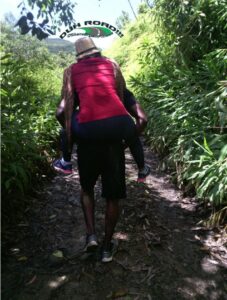
Enroll In Our Upcoming Hikes. Join our email community to stay up to date with our upcoming hikes. And enroll in our personal training system to be conditioned for your next hike (click image)
Introduction
Exercise & physical activity, while both beneficial to our health, can also be hazardous to our health and overall well-being. This is the case with low-impact, or low intensity exercise on relatively flat terrain and on undulating terrain (characteristic of hikes). The sudden and/or sustained increased heart rate, breathing rate and muscular force production of working muscles relative to the state of rest are roots of this kind of hazard to our bodies.
Examples of adverse outcomes due to exercise and/or physical activity-such as hiking include:
- Asthma Attack.
- Hypoglycemia (low blood sugar).
- Dehydration.
- Musculoskeletal Strains & Sprains.
- Muscle Cramps.
- Fainting.
Supporting Sources on Hiking Hazards That Are Exercise and/or Physical Activity Induced In Nature
1.”Although most hiking is uneventful, hiking can be dangerous. Exertional heat illness (EHI) is a common cause of mountain rescues, especially in hot environments. Exertional heat illness is a form of heat-related illness (HRI), which is caused by individual and/or environmental heat stress while performing physical activity. Such illnesses range in severity from heat edema, heat cramps, heat syncope, and heat exhaustion to life-threatening heat stroke.” Linsell et.al (2020)| Hiking Time Trial Performance In Heat with Real-Time Observation| Retrieved March 23, 2023
2. “As shown in a study at Shenandoah National Park, hiking is the most common activity that triggered injuries and illnesses. Other studies show that backpack-related injuries include foot blisters, lower back pain, chronic joint pain, compression of cervical spinal nerves known as rucksack palsy and paresthesia, a temporary numbing sensation affecting the legs, arms and feet.” Thomas, 2013| Effects of Pack Weight on Endurance of Long Distance Hikers| Retrieved March 23, 2023
Mitigation Tips for Exercise-Induced Hiking Hazards
To be successful in reducing the likelihood and/or severity of an adverse outcome in a hike, taking the preparatory steps (pre-planning stage); and executing the best response practices during and after an adverse outcome, are critical.
Pre-Planning Mitigation for Exercise Induced Hiking Hazards

Enroll In Our Upcoming Hikes. Join our email community to stay up to date with our upcoming hikes. And enroll in our personal training system to be conditioned for your next hike (click image)
- Fitness Conditioning-Enrolling in a physical fitness-building conditioning regimen for 3-6 months prior the scheduled hike. Specifically subjecting your body to a greater distance & steeper terrain, while walking at sub-maximal to maximal intensity in environmental conditions that simulate the conditions on the actual day of the hike, can go a far way.
- Nutrition/Dietary Conditioning- Consulting with a nutrition/dietary coach (if applicable), and implementing, or executing your dietary plan specific for your hike. As an endurance-dominant physical activity, nutrition for your hike the day before, can be such whereby you are carbohydrate loading. Similarly, you are ensuring you pack for your hike, the adequate hydration, rehydration salts, and fast-acting sugars (glucose, sport gels, breads, buns, fruits).
- First Aid Training- Enrolling in first aid courses, and ensuring you pack your first-aid kit specific for your hike, are critical. CPR classes, classes that cover how you treat sprains/fractures, antihistamine, asthma pump(prescribed), kit for puncture wounds and/or lacerations, are crucial.
- Communications-Ensuring you charge your cellular phone, and doing same for your power bank(s). Notifying the nearest police station before you set out on your hike, and doing same with your family at home; letting them know of your last known location(s), date, estimated date and/or time of return; as well as your dress.
- Companion-Identifying fellow hiker(s) for the journey. As a standard, avoid hiking on your own.
About The Author

Oshane Bryant: BSc Geology, Geography Minor; ACE CPT since 2012; Jamaica Business Development Corporation (JBDC) Accelerator Graduate-2018 cohort; Licensed KUKIBO Martial Arts & Self Defense, Senior Instructor; OB Fitness Founder & Managing Director.
